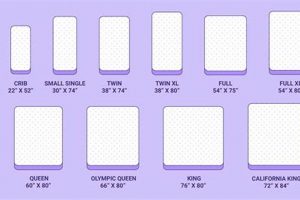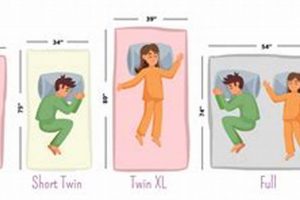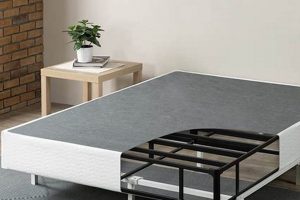A standard full-size mattress measures approximately 54 inches wide by 75 inches long. This dimension provides a sleeping surface suitable for single sleepers who desire more room than a twin offers, or for couples in smaller spaces. The mattress dimensions offer a balance between spaciousness and efficient use of floor area.
The popularity of this mattress dimension stems from its versatility. It comfortably accommodates a single adult while still fitting well in guest rooms or smaller apartments. Historically, it has served as a practical solution for individuals transitioning from a twin bed to a more spacious sleeping arrangement without requiring the footprint of a queen or king size.
Understanding the specific dimensions allows for informed decisions regarding bedroom layout, bedding purchases, and overall sleep comfort. Further exploration will delve into ideal room sizes, appropriate bedding options, and comparisons with other mattress sizes to facilitate the selection of the most suitable sleeping surface.
Selecting a Full-Size Mattress
Selecting the appropriate mattress involves careful consideration of several factors. These tips offer guidance in making an informed decision regarding this common mattress dimension.
Tip 1: Room Dimensions: Evaluate the room’s square footage. A full-size mattress, while compact, requires adequate space for movement and other furniture. Ensure a minimum of two feet of clearance around the bed.
Tip 2: Intended Occupancy: While suitable for couples, a full-size mattress offers limited personal space. If co-sleeping, consider the sleeping habits of both individuals to assess comfort levels.
Tip 3: Bedding Compatibility: Ensure that all bedding, including sheets, comforters, and mattress protectors, are specifically designed for full-size mattresses. Improperly sized bedding can affect comfort and mattress longevity.
Tip 4: Foundation Requirements: Verify the necessary foundation type. Some mattresses require a specific box spring or platform to ensure proper support and maintain warranty compliance.
Tip 5: Mattress Firmness: Consider individual sleep preferences. Full-size mattresses are available in various firmness levels, ranging from plush to extra-firm. Choosing the correct firmness is crucial for spinal alignment and overall comfort.
Tip 6: Budget Considerations: Establish a realistic budget. Prices for full-size mattresses can vary considerably based on materials, construction, and brand reputation. Compare options within the defined price range.
Tip 7: Trial Periods and Warranties: Prioritize vendors offering trial periods and comprehensive warranties. This allows for testing the mattress in a home environment and provides recourse in the event of manufacturing defects.
Careful consideration of room size, occupancy needs, bedding compatibility, foundation requirements, firmness preference, budget, and warranty coverage are crucial when selecting this particular mattress size.
By addressing these crucial elements, individuals can optimize their choice to ensure that their sleeping arrangment matches with their lifestyle.
1. Width (54 inches)
The 54-inch width is a defining characteristic of the double, or full-size, mattress. This measurement directly influences the sleeping space available, determining its suitability for single sleepers who desire more room than a twin bed offers, or for couples requiring a compact sleeping solution. A narrower width would compromise comfort, while a substantially wider dimension would classify the mattress as a different size category, such as a queen. The specified width directly reflects how a double size mattress functions, its role, and who it’s designed for.
For instance, a growing teenager transitioning from a twin bed might find the 54-inch width offers adequate space to stretch out and move comfortably during sleep. Conversely, two adults sharing a bed with this width might experience restricted personal space, potentially disrupting sleep quality. Manufacturers adhere to this standard width to ensure that bedding accessories, such as sheets and comforters, are compatible and readily available. Alterations to this measurement, even by a few inches, would necessitate custom-made bedding and potentially create instability on standard bed frames.
In summary, the 54-inch width is not an arbitrary dimension but rather a fundamental parameter that defines the practical utility and categorization of this particular mattress size. Understanding this measurement is crucial for consumers to accurately assess whether this size meets their specific needs and spatial constraints. This is the width that allows a double to fit in specific bed frames and certain room sizes, ensuring it is a highly functional mattress model.
2. Length (75 inches)
The 75-inch length is a critical dimension defining a double size mattress. This measurement directly influences the comfort and suitability of the mattress for individuals of varying heights. Understanding its implications is essential in determining if this mattress size aligns with individual needs.
- Accommodation of Average Height
The 75-inch length is generally suitable for individuals of average height, typically up to 5’10”. This length provides adequate space for comfortable sleep without the feet extending beyond the mattress edge. However, individuals exceeding this height may find the mattress restrictive, potentially leading to discomfort and disrupted sleep.
- Space Efficiency in Smaller Rooms
The 75-inch length contributes to the overall compactness of a double size mattress. This is particularly advantageous in smaller bedrooms where space is limited. The reduced length allows for efficient furniture placement and facilitates ease of movement within the room, making it a practical choice for apartments or guest rooms.
- Compatibility with Standard Bed Frames
The 75-inch length is a standard measurement adhered to by most mattress and bed frame manufacturers. This standardization ensures compatibility between mattresses and frames, simplifying the selection process and eliminating the need for custom-sized components. Adherence to this length also ensures the availability of appropriately sized bedding accessories.
- Impact on Sleep Posture
The available length can impact sleep posture. Insufficient length may force individuals to adopt a curled or fetal position, potentially leading to back pain and stiffness. Conversely, adequate length allows for a more relaxed and extended sleeping posture, promoting spinal alignment and reducing the risk of discomfort. The 75-inch length aims to strike a balance, accommodating a range of sleeping positions while maintaining overall mattress compactness.
The interplay between the 75-inch length and the other dimensions of a double size mattress determines its overall suitability for a given individual and room. This length, while adhering to established standards, must be carefully considered in relation to height and sleeping preferences to ensure optimal comfort and restorative sleep. For taller individuals, longer mattress options, such as queen or king sizes, may be more appropriate, while standard height sleepers can usually rest comfortably.
3. Surface Area (4050 sq. in.)
The surface area of approximately 4050 square inches is a direct consequence of the established dimensions of a double size mattress. This parameter significantly influences the comfort and practical applications of this mattress size, impacting factors ranging from individual sleep space to its suitability for various bedroom configurations.
- Individual Sleep Space
The 4050 square inches provide a tangible measurement of the available sleep area. For a single sleeper, this area offers ample room for movement and the adoption of various sleep positions without feeling confined. However, when shared by two individuals, this space is divided, potentially reducing individual comfort and increasing the likelihood of sleep disturbance due to motion transfer.
- Comparison to Other Mattress Sizes
The surface area allows for direct comparison with other mattress sizes. For example, a queen-size mattress offers a significantly larger surface area, translating to more personal space for couples. Conversely, a twin-size mattress provides considerably less space, making it suitable primarily for single sleepers. These comparisons provide a quantifiable basis for selecting the most appropriate mattress size based on individual or shared occupancy requirements.
- Impact on Room Layout
The total surface area influences room layout considerations. While a double size mattress is relatively compact compared to larger sizes, its 4050 square inches still require adequate floor space to ensure comfortable movement within the room. Smaller bedrooms may necessitate careful furniture placement to optimize space utilization and prevent overcrowding. The surface area directly impacts the usable space within the room and how furniture can be arranged.
- Bedding Requirements
The specified surface area determines the appropriate size for bedding accessories. Sheets, comforters, and mattress protectors must be designed to fit the dimensions of a double size mattress to ensure proper coverage and functionality. The standardized surface area ensures that these accessories are readily available and compatible with the mattress, simplifying the purchasing process and preventing fit issues.
In essence, the surface area of 4050 square inches is not merely a numerical value but a practical metric that influences the perceived comfort, spatial requirements, and accessory needs associated with a double size mattress. Understanding this parameter is crucial for making informed decisions regarding mattress selection and ensuring a satisfactory sleeping experience. The surface area works hand-in-hand with width and length to ensure this mattress serves its specific purpose.
4. Occupancy (One or Two)
The designated occupancy, whether for one or two individuals, is a critical factor influencing the suitability of a double size mattress. This parameter directly impacts comfort levels, sleep quality, and overall satisfaction with the mattress. The dimensions of the mattress dictate the space available per sleeper, making the occupancy rating a primary consideration.
- Single Occupancy Comfort
For a single occupant, a double size mattress provides ample space for movement and varying sleep positions. The generous width allows for comfortable stretching and reduces the likelihood of feeling confined during sleep. A single individual may find the double size mattress to be a comfortable and spacious option, particularly if they tend to move frequently during the night or prefer a larger sleeping surface than a twin bed provides.
- Dual Occupancy Considerations
When occupied by two individuals, the available space per sleeper is significantly reduced. The 54-inch width, when divided, offers each sleeper only 27 inches of personal space, which may be insufficient for comfortable sleep, particularly if one or both individuals are restless sleepers. This reduced space can lead to disrupted sleep, increased motion transfer, and a general sense of confinement. Co-sleeping on a double size mattress may be more suitable for occasional use or for individuals with smaller body frames.
- Impact on Sleep Quality
The occupancy level directly influences sleep quality. Single sleepers on a double size mattress are less likely to experience sleep disturbances related to space constraints. Conversely, couples may encounter issues such as restricted movement, increased body heat, and heightened sensitivity to each other’s movements, potentially resulting in fragmented and less restorative sleep. Sleep quality may be improved with larger mattresses such as queen or king size beds.
- Alternative Mattress Options
The intended occupancy should guide the selection of mattress size. If the mattress is primarily intended for a single individual, a double size may be a suitable choice. However, if the mattress is intended for regular dual occupancy, a larger mattress size, such as a queen or king, is generally recommended to provide adequate personal space and minimize sleep disruptions. Considering alternative mattress options based on occupancy is crucial for ensuring optimal sleep comfort and overall satisfaction.
In conclusion, the occupancy rating of a double size mattress is a crucial determinant of its suitability for individual or shared sleep. The dimensions provide different levels of space depending on the occupancy, significantly impacting both sleep quality and comfort. Recognizing the implications of single versus dual occupancy is essential for selecting a mattress size that aligns with individual sleeping habits and preferences.
5. Room Size (Minimum 10×10 ft)
The recommended minimum room size of 10×10 feet is a crucial factor to consider when evaluating the suitability of a double size mattress. This dimension impacts the overall functionality and comfort of the bedroom, influencing factors from ease of movement to the placement of accompanying furniture.
- Functional Space and Circulation
A 10×10-foot room provides sufficient space for a double size mattress while still allowing for adequate circulation. This ensures ease of movement around the bed and access to other areas of the room, preventing a feeling of confinement. Smaller rooms may feel cramped and limit the usability of the space. For instance, attempting to fit a double size mattress into a 9×9-foot room could significantly impede movement and hinder access to closets or dressers. If an individual has a smaller space, they might opt for a Twin mattress instead.
- Furniture Placement and Aesthetics
The 10×10-foot minimum allows for the inclusion of essential bedroom furniture, such as nightstands, dressers, and chairs, without overcrowding the space. This contributes to the overall aesthetic appeal of the room and enhances its functionality. Insufficient room size may necessitate compromising on furniture choices or arranging furniture in a way that obstructs movement. A larger room would allow for more furniture and a more aesthetically pleasing look. A minimum of 10×10 allows the furniture to breathe.
- Visual Balance and Proportions
A room size of 10×10 feet generally provides a visually balanced environment for a double size mattress. The proportions are such that the bed does not dominate the space, creating a more harmonious and inviting atmosphere. Smaller rooms may create a visual imbalance, with the mattress appearing disproportionately large and overwhelming the space. Larger spaces might dwarf the mattress and make the room feel empty.
- Impact on Sleep Quality
The overall room size can indirectly impact sleep quality. A cramped and cluttered room can contribute to feelings of stress and anxiety, potentially disrupting sleep patterns. A well-proportioned and organized room, facilitated by adequate square footage, can promote a sense of calm and relaxation, creating a more conducive environment for restorative sleep. Making sure the space feels restful is key to optimal sleep.
The 10×10-foot minimum room size recommendation is a pragmatic guideline for ensuring both functionality and comfort when incorporating a double size mattress into a bedroom. Adhering to this recommendation allows for optimized space utilization, appropriate furniture placement, and a visually balanced environment, all contributing to an improved overall bedroom experience. Larger bedrooms may require larger mattresses such as queen, king, or california king.
Frequently Asked Questions
The following addresses common inquiries regarding the dimensions and applications of a double size mattress, providing clarity and practical guidance.
Question 1: What are the precise measurements of a double size mattress?
A double size mattress measures 54 inches in width and 75 inches in length, resulting in a surface area of 4050 square inches. These dimensions adhere to industry standards and ensure compatibility with appropriately sized bedding and bed frames.
Question 2: Is a double size mattress suitable for couples?
While a double size mattress can accommodate two individuals, the limited width may result in a restricted personal space and potential sleep disturbance. Couples who prefer more individual space may find a queen or king-size mattress more comfortable.
Question 3: What is the recommended room size for a double size mattress?
A minimum room size of 10×10 feet is generally recommended to ensure adequate circulation and allow for the inclusion of essential bedroom furniture without overcrowding the space.
Question 4: Can standard bedding be used on a double size mattress?
Yes, standard bedding specifically designed for double size mattresses will fit properly. Ensure that sheets, comforters, and mattress protectors are labeled as “full” or “double” to guarantee compatibility.
Question 5: How does a double size mattress compare to a queen-size mattress?
A queen-size mattress is wider and longer than a double size mattress, offering significantly more space for couples or single sleepers who desire a larger sleeping surface. A queen measures 60 inches wide and 80 inches long.
Question 6: Is a specific type of bed frame required for a double size mattress?
A standard double size bed frame or platform bed is appropriate. Ensure the frame provides adequate support for the mattress and complies with the manufacturer’s recommendations to maintain warranty validity.
Understanding these key aspects of this mattress size allows for informed decision-making, ensuring a comfortable and well-suited sleeping arrangement.
Further exploration will delve into the best mattresses, and compare the double to twin XL and other common bed types, providing further practical insights for readers.
Concluding Insights
This exploration into what size is a double size mattress has clarified its standardized dimensions of 54 inches by 75 inches, highlighting its utility for single sleepers and its limitations for couples. Key considerations include room size, intended occupancy, and the crucial interplay between mattress dimensions and individual comfort. The discussion has underscored that the double size mattress offers a balance between space efficiency and sleeping area.
The informed selection of a mattress size is paramount for ensuring sleep quality and overall well-being. While this article has focused on the specifications of the double size mattress, further research into alternative mattress sizes, materials, and construction methods is encouraged to optimize the sleep experience. It is essential to consider all factors, including room dimensions, sleep habits, and occupancy needs, to make an informed choice. The data that goes into choosing the right mattress model can be life-changing.





![Best Coleman Queen Size Air Mattress [Guide] Organic & Natural Mattress Buyer’s Guide: Non-Toxic Sleep Solutions Best Coleman Queen Size Air Mattress [Guide] | Organic & Natural Mattress Buyer’s Guide: Non-Toxic Sleep Solutions](https://mattressworldpa.com/wp-content/uploads/2025/07/th-2264-300x200.jpg)

